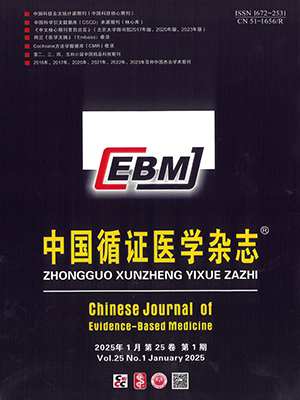| 1. |
中国高血压防治指南修订委员会.中国高血压防治指南(2010).中华高血压杂志, 2011, 19(8):701-743.
|
| 2. |
中华人民共和国卫生部药政局.新药(西药)临床研究指导原则汇编:心血管系统药物研究指导原则. 1993:48-49.
|
| 3. |
Higgins JPT, Green S (editors). Cochrane Handbook for Systematic Reviews of Interventions Version 5.1.0[updated March 2011]. The Cochrane Collaboration, 2011. Available from www.cochrane-handbook.org.
|
| 4. |
李晓红, 黄爱东, 刘博宏, 等.氨氯地平治疗原发性高血压临床观察.中国现代医学杂志, 1997, 7(9):28-29.
|
| 5. |
王跃红, 林桦, 谢强.氨氯地平与吲达帕胺对原发性高血压的疗效比较.中国基层医药, 1999, 6(3):9.
|
| 6. |
刘京亮, 曹志峰, 王凤梅, 等.氨氯地平、福辛普利及吲达帕胺降压效果的对比分析.铁道医学, 2000, 28(3):194-195.
|
| 7. |
曹志峰, 段红, 宋丽茹.氨氯地平、福辛普利、吲达帕胺降压效果的对比分析.中国医院药学杂志, 2001, 21(5):41-42.
|
| 8. |
王悦, 李鲁, 何炳荣, 等.中西降压药的成本-效果分析综合评价.中国中西医结合杂志, 2001, 21(9):663-666.
|
| 9. |
Emeriau JP, Knauf H, Pujadas JO, et al. A comparison of indapamide SR 1.5 mg with both amlodipine 5 mg and hydrochlorothiazide 25 mg in elderly hypertensive patients:A randomized double-blind controlled study. J Hypertens, 2001, 19(2):343-350.
|
| 10. |
苏宗霞, 曹培义.四种降压药的成本效果分析.现代医药卫生, 2002, 18(12):1095.
|
| 11. |
徐雯.氨氯地平、福辛普利、吲达帕胺降压效果的药物经济学评价.海峡药学, 2003, 15(3):67-69.
|
| 12. |
胡应权.氨氯地平、福辛普利、吲达帕胺降压效果的药物经济学分析.国际医药卫生导报, 2004, 10(14):152-153.
|
| 13. |
Libhaber EN, Libhaber CD, Candy GP, et al. Effect of slow-release indapamide and perindopril compared with amlodipine on 24-hour blood pressure and left ventricular mass in hypertensive patients of African ancestry. Am J Hypertens, 2004, 17(5):428-432.
|
| 14. |
陶洪夏, 高传玉.吲达帕胺治疗老年收缩期高血压疗效及安全性观察.陕西医学杂志, 2005, 34(12):88-89.
|
| 15. |
Leonetti G, Emeriau JP, Knauf H, et al. Evaluation of long-term efficacy and acceptability of indapamide SR in elderly hypertensive patients. Curr Med Res Opin, 2005, 21(1):37-46.
|
| 16. |
伍三妹, 熊国红.左旋氨氯地平与寿比山治疗原发性高血压的疗效比较.医药世界, 2006, (12):88-89.
|
| 17. |
London G, Schmieder R, Calvo C, et al. Indapamide SR versus candesartan and amlodipine in hypertension:The X-CELLENT study. American Journal of Hypertension, 2006, 19(1):113-121.
|
| 18. |
Piecha G, Adamczak M, Chudek J, et al. Indapamide decreases plasma adiponectin concentration in patients with essential hypertension. Kidney Blood Press Res, 2007, 30(3):187-194.
|
| 19. |
刘健, 匡红英.苯磺酸氨氯地平片与吲达帕胺片治疗原发性高血压高龄患者的疗效比较.湖南师范大学学报(医学版), 2008, 5(3):26-28.
|
| 20. |
张新平, 刘国英, 闫凤茹.吲达帕胺治疗老年单纯收缩期高血压的临床价值.山西医科大学学报, 2008, 30(1):49-51.
|
| 21. |
和家红.吲达帕胺治疗老年单纯收缩期高血压疗效观察.中国疗养医学, 2009. 18(3):275-276.
|
| 22. |
黄爱荣, 黄时美, 黄庭标, 等. 3种不同药物对高血压患者降压效果及其消费成本的对比分析.中国医院用药评价与分析, 2009, 9(6):460-462.
|
| 23. |
李琳, 赵运梅, 李勇胜, 等.吲哒帕胺缓释片与左旋氨氯地平片对老年单纯收缩期高血压的疗效和安全性比较.中国老年学杂志, 2009, 11(21):2808-2809.
|
| 24. |
岳晓春.吲达帕胺治疗老年单纯收缩期高血压疗效观察.四川医学, 2009, 30(6):932-933.
|
| 25. |
覃艺中.吲达帕胺治疗高血压病疗效观察.医学文选, 1999, 18(6):40-41.
|
| 26. |
李云富, 耿秀双, 郭俊芳, 等.动态血压监测比较吲哒帕胺和非洛地平的降压疗效.河南实用神经疾病杂志, 2001, 4(1):67-68.
|
| 27. |
邵磊, 范俊生, 黄兴华, 等.非洛地平对高血压患者大动脉内皮功能和左室肥厚的影响.实用诊断与治疗杂志, 2003, 17(3):168-170.
|
| 28. |
杨玺.吲达帕胺治疗老年单纯收缩期高血压疗效及其对代谢的影响.临床心血管病杂志, 2003, 6(3):149-151.
|
| 29. |
吴志文, 张祎.吲达帕胺和波依定治疗老年收缩期高血压临床观察.中国综合临床, 2004, 20(13):13.
|
| 30. |
马国军.四种药物对老年性纯收缩期高血压影响.医药论坛杂志, 2006, 27(5):68.
|
| 31. |
唐仁斌, 伍三妹, 唐莼, 等.寿比山和波依定治疗农村原发性高血压患者临床效果观察.右江医学, 2006, 34(5):484-485.
|
| 32. |
金智敏.原发性高血压目标降压治疗的临床研究.上海预防医学杂志, 2001, 13(8):363-364.
|
| 33. |
Senior R, Imbs JL, Bory M, et al. Indapamide reduces hypertensive left ventricular hypertrophy:An international multicenter study. J Cardiovasc Pharmacol, 1993, 22(Suppl 6):S106-S110.
|
| 34. |
孙昌明.吲达帕胺治疗高血压疗效观察.临床心血管病杂志, 1999, 15(3):131-132.
|
| 35. |
蒋和平.吲哒帕胺治疗高血压病的临床观察.现代诊断与治疗, 2001, 12(6):365.
|
| 36. |
张路毅, 潘伟民, 陈祖煖, 等.吲达帕胺与硝苯地平对轻、中度高血压病人生活质量影响的比较.中国新药与临床杂志, 2001, 20(3):179-181.
|
| 37. |
唐淑华.吲哒帕胺治疗高血压病观察.中华医学写作杂志, 2001, 8(24):2746-2747.
|
| 38. |
孙东臣, 徐勇, 赵静.吲满酰胺治疗原发性高血压病66例.中国药业, 2002, 11(3):73-74.
|
| 39. |
刘芬, 王学敬.吲哒帕胺治疗原发性高血压40例疗效观察.山东医药, 2003, 43(11):19.
|
| 40. |
卫莉玲.吲达帕胺对高血压左心室肥厚的改善作用.中国民康医学, 2007, 19(8):636-637.
|
| 41. |
王定营, 杨巍. 3种医保药物治疗高血压的成本-效果分析.右江民族医学院学报, 2008, (2):278-279.
|
| 42. |
黄改荣, 侯淑彦, 高恩民.吲达帕胺降压疗效观察.河南诊断与治疗杂志, 1996, 10(2):116.
|
| 43. |
简修玉.吲达帕胺治疗老年性高血压31例的临床观察.现代医药卫生, 2002. 18(4):274-275.
|
| 44. |
陈鲁原, 林曙光.吲哒帕胺和尼群地平对高血压病患者左室肥厚及功能影响的对比性研究.中国临床药理学杂志, 1994, 10(4):211-214.
|
| 45. |
陈金梅, 施洪礼, 吴敏.吲达帕胺和尼群地平对老年人高血压病的疗效对照.天津药学, 2002, 14(6):52-53.
|
| 46. |
Brodszky V, Nagy V, Farsang C, et al. The efficacy of indapamide in different cardiovascular outcome meta-analysis. Orv Hetil, 2007, 148(26):1203-1211.
|




